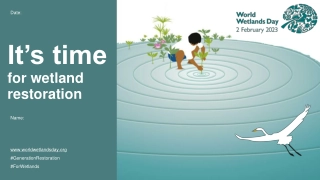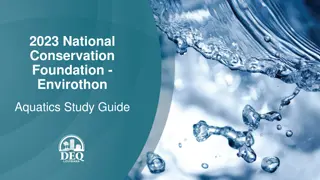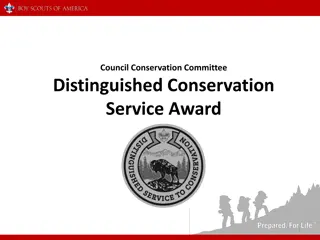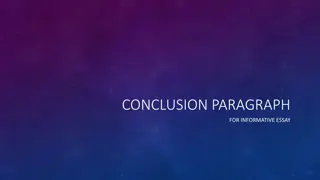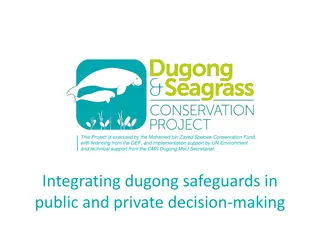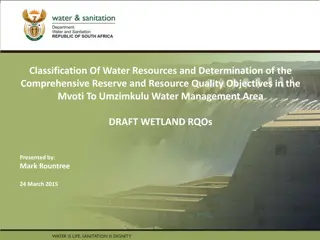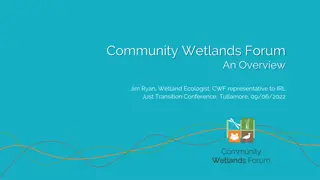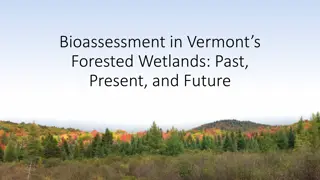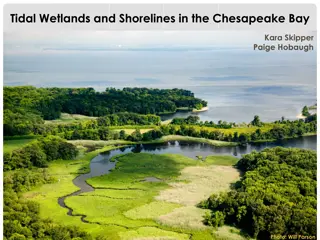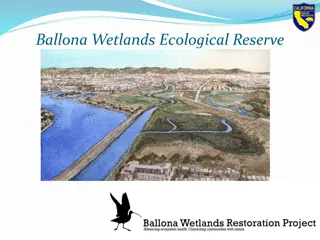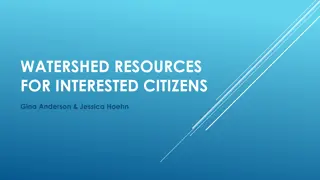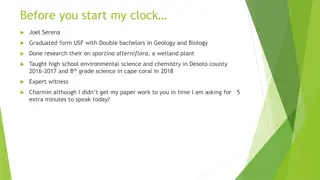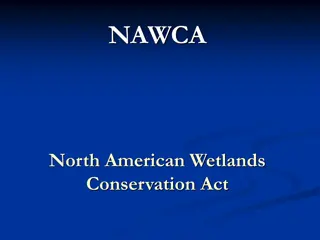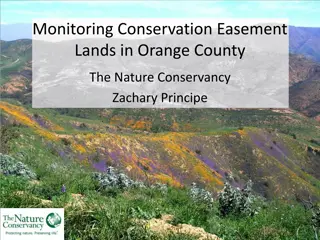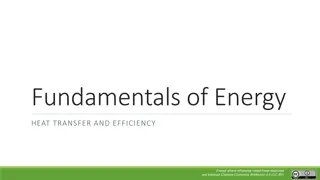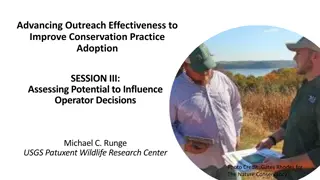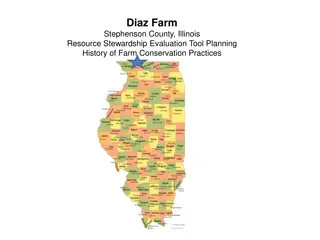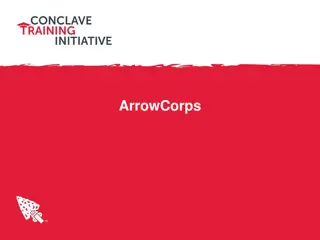World Wetlands Day 2022: Taking Action for Wetlands Conservation
World Wetlands Day is an annual event celebrated on February 2nd to raise awareness about the importance of wetlands for people and the planet. This year's theme, "Wetlands Action for People and Nature," emphasizes the urgent need for increased investment in the conservation of wetlands to ensure their sustainable use. Natural wetlands are in decline, with 35% lost since 1970, and various factors like climate change, draining, overfishing, pollution, and water extraction are contributing to wetland loss. These biodiverse ecosystems cover about 6% of the Earth's land surface and play a crucial role in supporting human well-being, culture, and the health of the planet. It's essential to manage and restore wetlands to prevent further degradation and safeguard their benefits for future generations.
Download Presentation

Please find below an Image/Link to download the presentation.
The content on the website is provided AS IS for your information and personal use only. It may not be sold, licensed, or shared on other websites without obtaining consent from the author. Download presentation by click this link. If you encounter any issues during the download, it is possible that the publisher has removed the file from their server.
E N D
Presentation Transcript
WETLANDS VALUE MANAGE RESTORE LOVE www.worldwetlandsday.org #ActForWetlands #WorldWetlandsDay
World Wetlands Day An annual opportunity to unite for wetlands Far-reaching event that heightens awareness of critical importance of wetlands to people and the planet Celebrated every 2 February since 1997 by Parties to the Convention on Wetlands and others Marks anniversary of the Convention on Wetlands adopted in 1971 as an international treaty First of the modern global multilateral environmental agreements Only one devoted to a specific ecosystem wetlands For first time ever, will be officially observed within context of United Nations UN General Assembly adopted it as an international day 2022 Theme Wetlands Action for People and Nature An urgent call for greater investments of financial, human and political capital to conserve wetlands and ensure they re used wisely and sustainably #ActForWetlands #WorldWetlandsDay WorldWetlandsDay.org
Natural wetlands are declining Status and Trends 35% of the world s wetlands have been lost since 1970. Wetlands are disappearing three times faster than forests. Wetland dependent plants, species and animals are at risk of extinction Human wellbeing, livelihoods and the health of the planet are threatened. Sources: Summary of the Thirteenth Meeting of the Conference of the Parties to the Ramsar Convention on Wetlands | Ramsar Wetlands world s most valuable ecosystem disappearing three times faster than forests, warns new report | Ramsar Global Wetlands Outlook 2018
Drivers of wetland loss and degradation Sustainable use of wetlands requires an understanding of the drivers of wetland loss and degradation so that the root causes can be addressed. Over Climate Change Draining and infilling Overfishing Pollution Extraction 0f Water Sources: Global Wetlands Outlook 2018
Wetlands are biodiverse and essential ecosystems Wetlands currently cover roughly 6% of the Earth s land surface. They can be saltwater or freshwater, inlandor coastal, natural or human-made. Freshwater wetlands include: rivers, lakes, pools, flood plains, peatlands, marshes, swamps Saltwater wetlands include: estuaries, mudflats, saltwater marshes, mangroves, lagoons, coral reefs, shellfish reefs Human-made wetlands include: fishponds, rice paddies, reservoirs, saltpans
Wetlands loss affects people and the planet Human well-being Well-being and culture Wetlands provide recreation spaces, cultural engagement and mental health benefits tied to interacting with nature. Water security Wetlands provide almost all our fresh water. The Earth s kidneys, wetlands silt-rich soil and plants filter against harmful toxins, agricultural pesticides and industrial waste leaving safe water to drink. The UN Water Report (2018) mentions wetlands as nature-based solutions that can help improve water quality. There are already 2.2 billion people without safe drinking water, and 485,000 die each year. Water insecurity is a major role in conflict in at least 45 countries in 2017. Sources: factsheet_wetland_restoration_general_e_0.pdf (ramsar.org) Slide 1 (ramsar.org) factsheet_wetland_restoration_peatlands_e.pdf (ramsar.org)
Wetlands loss affects people and the planet Climate regulation and human safety Biodiversity Wetlands are natural shields and help us cope with climate change and its impacts. Wetlands safeguard the 60% of humanity along coastlines against storm surges, hurricanes and tsunamis. Each acre of inland wetlands absorbs up to 1.5 million gallons of floodwater, helping to reduce floods and delay and relieve droughts. Coastal wetlands sequester and store carbon up to 55X faster than tropical rain forests. Peatlands store ~30% of land-based carbon 2X the amount of all the world s forests. Drained peatlands and peatland fires are responsible for an estimated 4% of global anthropogenic greenhouse gas emissions. 40% of the world s plant and animal species live or breed in wetlands Rich nutrients carried by rivers, streams and water power the food chain. >100,000 freshwater species identified in wetlands. Home to 30% of known fish species, with 200 new freshwater species discovered each year Sources: WWD19_2Handout_english.indd (ramsar.org) wwd16_hand-outs_desktop_print_eng.pdf (ramsar.org) Ramsar-50-Factsheet-BIODIVERSITY-English.pdf (ramsar50.org) Summary of the Thirteenth Meeting of the Conference of the Parties to the Ramsar Convention on Wetlands | Ramsar
Take 3 actions to reverse wetlands loss Three Response Actions MANAGE them wisely and use sustainably to conserve and maintain their health VALUE their multiple benefits and nature-based solutions RESTORE to revive biodiversity and life
1 Value wetlands Throughout history wetlands have been viewed as wastelands. We can value wetlands by: Recognizing the multiple benefits and nature-based solutions they provide All of society understands the full range of economic, social-cultural and environmental benefits, goods and services wetlands offer. Capturing the importance of wetlands through economic valuation: Capturing the monetary benefits and economic value helps convince decision-makers faced with trade-offs. It generates information about the goods and services that wetlands offer providing a basis for policy formation and analysis. Ensuring that policies and decision-making reflect the full value of wetlands: Incorporate wetland conservation and wise use into national policy plans and actions including the designation of Wetlands of International Importance, wetland inventories, and laws and policies that regulate activities in wetlands. Sources: TEEB Approach Barbier, Acrerman and Knowler, in Economic Valuation of Wetlands: A Guide for Policy Makers and Planner
2 Manage wetlands Managing wetlands wisely and using them sustainably conserves and maintains their health. The Convention defines wise use as the maintenance of the ecological character of wetlands, achieved through the implementation of ecosystem approaches, within the context of sustainable development. Ecological character is the characteristics of a wetland at a given time the combination of its components, processes, benefits and services. Actions that will promote the wise use of wetlands include: Adopt national wetland plans, policies and legislation separately or as a part of wider initiatives Create programs covering wetland inventory, monitoring, research, training, education and public awareness Develop integrated management and wise use plans at wetland sites Include area stakeholders in discussions from the start Undertake wetlands inventory and impact assessments Name or create an authority to implement the plan Monitor the site for changes Apply for Ramsar Site designation Sources: factsheet2_wise_use_basics_0.pdf (ramsar.org) The Wise Use of wetlands | Ramsar
3 Restore lost and degraded wetlands Essential elements for restoring wetlands Manage water Understand waterflow patterns and conduct hydrological restoration Construct flood mitigation systems Build storm water treatment areas Rewet peatlands Reestablish suitable vegetation Reforest mangroves and other vegetation Create community nurseries to produce seedlings Manage pollution Close or dismantle illegal structures Manage solid waste Conduct cleanups Involve the local community Draw knowledge from indigenous communities Create community monitoring systems to ensure the protection and conservation of the wetlands Establish public-private partnership programs The UN Decade on Ecosystem Restoration 2021-2030 offers the opportunity to join efforts to reverse the degradation of our planet s wetlands nearly 90% have been degraded since the 1700s. Sources: factsheet_wetland_restoration_general_e_0.pdf (ramsar.org) factsheet_wetland_restoration_peatlands_e.pdf (ramsar.org) factsheet_wetland_restoration_coastal_e.pdf (ramsar.org)
The wise and sustainable use of wetlands is not only possible its critical to the future of humanity and the planet. Continued harm to these life-sustaining ecosystems will have dire consequences if we don t act now. In many ways, wetlands are our lifeline to the future. And we must make the necessary investments of time, capital and heart to save them. Martha Rojas Urrego Secretary General of the Convention on Wetlands


